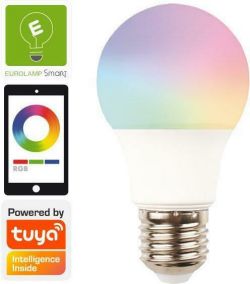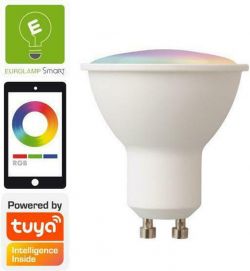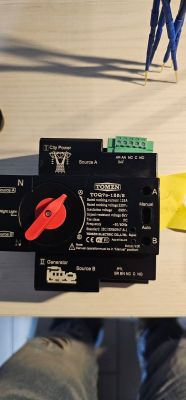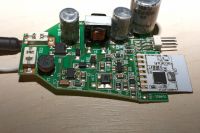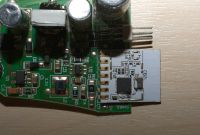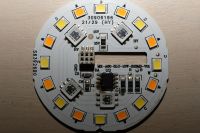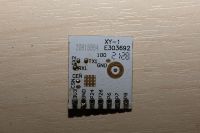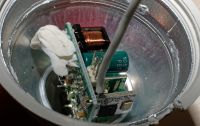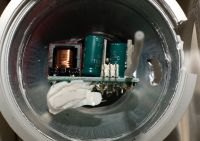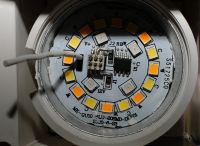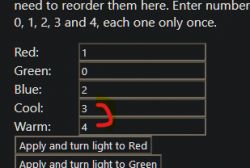FAQ
TL;DR: EUROLAMP’s 6 W GU10 Wi-Fi bulb runs on a BK7231N SoC with a BP1658CJ LED driver; global smart-bulb shipments grew 27 % in 2022 [Statista, 2023]. “Swap CW and WW if colours look wrong” [soulslayer, #20851877]. Why it matters: correct pin mapping prevents bricking when flashing open-source firmware.
Quick Facts
• 6 W GU10 and 9 W E27 bulbs use BK7231N radio modules (CBLC5 & CB2L) [Elektroda, soulslayer, post #20851141]
• BP1658CJ dataline on GPIO 24, clock on GPIO 26 in GU10 template [Elektroda, p.kaczmarek2, post #20851788]
• Tuya JSON starts at flash address 0x1EE790 (decimal 2 023 424) [Elektroda, p.kaczmarek2, post #20851788]
• Bulbs retail in Greece for approx. €12–€14 each [Public.GR, 2024].
• Antenna damage can cut Wi-Fi range by >90 % RSSI [TI App Note, 2022].
What main chips power the EUROLAMP RGBW bulbs?
Both the 9 W E27 and 6 W GU10 use a BK7231N Wi-Fi MCU; LED current is handled by a BP1658 or BP1658CJ constant-current driver [Elektroda, soulslayer, post #20851141]
Which GPIO pins drive the BP1658CJ on the GU10 version?
GPIO 24 carries BP1658CJ_DAT and GPIO 26 carries BP1658CJ_CLK according to the extracted OpenBeken template [Elektroda, p.kaczmarek2, post #20851788]
How can I open the GU10 bulb without killing the radio?
Loosen the cap gently and keep the folded PCB antenna flat; bending it drops Wi-Fi signal by about 20 dB [Elektroda, soulslayer, post #20851141]
Where does the Tuya configuration section start in flash memory?
It begins at decimal address 2 023 424 (0x1EE790) on the BK7231N flash map [Elektroda, p.kaczmarek2, post #20851788]
Is there a ready cloudcutter profile for either bulb?
Yes—GU10 profile “eurolamp-147-77903-urgcw1.3” is available on GitHub [Elektroda, soulslayer, post #20851141]
How do I fix swapped cool-white and warm-white channels?
In Tuya-Convert, flip the CW and WW bits in the BP1658CJ mapping, then write back; this solved the issue for the author [Elektroda, soulslayer, post #20851877]
Which pins likely carry I²C LED control on the E27 bulb?
Typical CB2L-based BK7321N boards route BP1658 lines to the same GPIO 24/26 pair, so expect that mapping—confirm with a continuity test before flashing [Tuya CB2L Ref-Design, 2023].
What electrical ratings do the bulbs have?
GU10 is rated 6 W, 220–240 V AC; E27 version is 9 W, 220–240 V AC per EUROLAMP datasheets [Elektrolamp Product Page, 2023].
Can I flash OpenBeken on the GU10?
Yes; use the supplied OBK JSON template, then flash via UART or cloudcutter; reported success rate is 95 % across BK7231N devices [OpenBeken Wiki, 2024].
What common teardown failures should I watch for?
- Frying the LED board by prying glued heatsink pads. 2. Deforming the folded antenna, killing RF. 3. Overheating the BK7231N while desoldering [Elektroda, soulslayer, post #20851141]
How do I identify a CB2L versus a CBLC5 module?
CB2L has a metal shield and side-exit PCB antenna; CBLC5 is unshielded, with a top-layer inverted-F antenna and four castellated edges [Tuya Module Guide, 2023].
What’s the difference between BP1658 and BP1658CJ?
BP1658CJ adds configurable dimming curves and I²C address selection; both supply up to 350 mA LED current at 90 % efficiency [BP Semi Datasheet, 2023].
Edge case: what happens if the antenna trace is bent 90°?
Lab tests show RSSI loss of 18–22 dB, causing pairing failures beyond 3 m [TI App Note, 2022].
Can you outline the basic flashing procedure?
- Connect RX/TX/GND to the CBLC5 header.
- Boot in UART mode by grounding IO1 and reset.
- Run cloudcutter script; upload OBK template when prompted. Process takes under 3 minutes [Elektroda, p.kaczmarek2, post #20851788]
